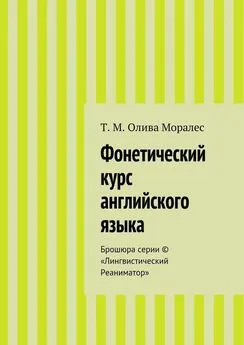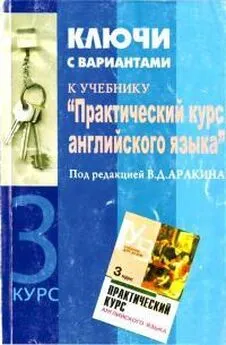Яков Аракин - Практический курс английского языка 2 курс
- Название:Практический курс английского языка 2 курс
- Автор:
- Жанр:
- Издательство:ВЛАДОС
- Год:2005
- ISBN:нет данных
- Рейтинг:
- Избранное:Добавить в избранное
-
Отзывы:
-
Ваша оценка:
Яков Аракин - Практический курс английского языка 2 курс краткое содержание
I - V курсов педагогических вузов.
Цель учебника – обучение устной речи на основе развития необходимых автоматизированных речевых навыков, развитие техники чтения, а также навыков письменной речи.
Практический курс английского языка 2 курс - читать онлайн бесплатно полную версию (весь текст целиком)
Интервал:
Закладка:
serve only tinned food for all the meals. The other points out that tinned food alone will never do and
suggests other ways of solving the problem.
XVII. Brash up your table manners.
A. Answer the following questions and then check your answers by comparing
litem with the answers below:
1. What is the correct way to sit at table? 2. Should you use your fork or your knife for taking
a slice of bread from the bread-plate? 3. How should you get a slice of bread from the plate standing
on the far end of the table? 4. What is the correct way of using spoon, fork and knife? 5. How should
you cut your meat? 6. What are the dishes for which knife shouldn't be used? 7. What is the way to
eat chicken? 8. What is one supposed to do with the stones while eating stewed fruit? 9. What should
you do with the spoon after stirring your tea? 10. What should you do if your food is too hot? 11.
What should you say to refuse a second helping? 12. What should you say if you like the dish very
much? 13. What should you say if you dislike the dish? 14. What shouldn't one do while eating? 15.
Where should one keep the newspaper or the book during a meal, on the table or on one's lap?
В. Make up dialogues discussing good and bad table manners. Use the
material of Section A for questions and that of Section В for answers.
Answers to Exercise XVII.
a) "It tastes (really) fine" or "It is delicious."
b) Never eat the stones (trying to be overpolite). Neither would it be a good idea to dispose of
them by dropping them under the table, placing them in your pocket or in your neighbour's wine-
glass. Just take them from your mouth on your spoon and place them on your own saucer.
c) Nowhere near the table. Reading at one's meals is a bad habit; it is bad for your digestion
and impolite towards others sitting at the same table.
d) Sit straight and close to the table. Don't put your elbows on the table. Don't cross your legs
or spread them all over the place under the table.
e) Never lean across the table or over your neighbours to get something out of your reach.
Just say: "Please pass the bread." Or. "Would you mind passing the bread, please?"
f) Nothing. Keep your impressions to yourself and don't embarrass your hostess.
g) Fish dishes are generally eaten without using knife. If one does, it is considered a serious
breach of good table manners. The same refers to rissoles, cereal and, in general, to anything that is
soft enough to be comfortably eaten with spoon or fork.
h) Neither. Your hand is quite correct for getting a slice of bread for yourself. After all, it is
you who is going to eat it.
i) While eating, one should produce as little noise or sound as possible. It is decidedly bad
manners to speak with your mouth full. Don't put your bread in your soup. Don't pour your tea in
your saucer. Don't leave much on the plate: it is impolite towards your hostess. If you have liked the
dish, it doesn't follow that you should polish the plate with your bread.
j) Don't hold your spoon in your fist, don't tilt it so as to spill its contents. The fork should be
held in your left hand, the knife in your right.
k) It is wrong first to cut all the meat you have got on your plate in small pieces and then eat
it. Cut off a slice at a time, eat it, then cut off another, holding your knife in the right hand and your
fork in the left.
l) "No more, thank you."
m) Cut off and eat as much as possible by using your knife and fork; the remaining part eat
by holding the piece in your hand by the end of the bone.
n ) Never cool your food by blowing at it. Just wait a bit, there is no hurry.
o) Don't leave your spoon in the glass while drinking. Put it on your saucer.
XVIII. a) Read and translate the following extracts:
1. Breakfast in the Jenssen home was not much different from breakfast in a couple of
hundred thousand homes in the Great City. Walter Jenssen had his paper propped against the vinegar
cruet and the sugar bowl. He read expertly, not even taking his eyes off the printed page when he
raised his coffee cup to his mouth. Paul Jenssen, seven going on eight, was eating his hot cereal,
which had to be sweetened heavily to get him to touch it. Myrna Jenssen, Walter's five-year-old
daughter, was scratching her towhead with her left hand while she fed herself with her right. Myrna,
too, was expert in her fashion: she would put the spoon in her mouth, slide the cereal off, and bring
out the spoon upside down. Elsie Jenssen (Mrs. Walter) had stopped eating momentarily the better to
explore with her tongue a bicuspid (коренной зуб) that seriously needed attention.
(From "The Ideal Man" by J. O'Hara)
b) Comment on the table manners of the Jenssen family and say what you
would do if you were the father or the mother:
2. While Anna prepared herself to meet her class of fortysix lively and inquisitive children
her landlady was busy preparing the high tea for her husband and the new lodger.
She had screwed the old mincer to the kitchen table and now fed it with rather tough strips of
beef, the remains of the Sunday joint. There was not much, to be sure, but Mrs. Flynn's pinch-penny
spirit had been roused to meet this challenge and the heel of a brown loaf, a large onion, and a
tomato on the table were the ingredients of the rest of the proposed cottage pie.
"If I open a tin of baked beans," said Mrs. Flynn aloud, "there'll be no need for gravy, I shan't
waste gas unnecessarily!" She pursed her thin lips with satisfaction, remembering, with sudden
pleasure, that she had bought the beans at a reduced price as "This Week's Amazing Offer" at the
local grocer's. She twirled the handle of the mincer with added zest.
Yesterday's stewed apple, she thought busily, could be served out with a little evaporated
milk, in three individual dishes. A cherry on top of each would make a nice festive touch, decided
Mrs. Flynn in a wild burst of extravagance. She straightened up from her mincing and opened the
store cupboard where she kept her tinned and bottled food. In the front row a small jar of cherries
gleamed rosily. For one long minute Mrs. Flynn studied its charms, torn between opposite forces of
art and thrift. Victory was accomplished easily. "Pity to open them," said Mrs. Flynn, slamming the
cupboard door and returned to her mincing. ( From "Fresh from the Country" by M. Reed)
c) Comment on the character of the landlady. Prove your statement.
XIX. Try your hand at teaching:
A. Preparation.Find some pictures and jokes on the topic and prepare to work with them in
class. (See "Classroom English", Sections VII, VIII.)
B. Work in Class. 1. Tell a joke or show and describe a picture to the class. 2. Ask some
questions to see if the listeners have grasped the meaning of your story. 3. If you want the students to
use some new words write them on the blackboard, translate them, practise their pronunciation (in
chorus) or usage (by making the students translate your sentences from English or Russian). 4. Tell
the joke or describe the picture once more. 5. Make 1—2 students retell the joke (describe the
picture) or make up a dialogue on the subject. 6. Correct the mistakes after the student has finished
speaking. (See "Classroom English", Sections IX, X.)
XX. Role-playing:
Arrange a tea-party (at home or in the canteen). Two of the students are to act as host and
hostess, having some friends round (2 or 3 of them are English). The main topic discussed at the
party is traditions connected with meals. Each member of the group must tell a short story, joke or
proverb to entertain the party.
XXI.. Arrange short debates on the following questions:
1. Should we stick to our custom of giving our guests a substantial meal? 2. How do you like
the idea of celebrating family holidays in a cafe or restaurant? 3. Are old traditions, worth keeping?
STUDIES OF WRITTEN ENGLISH
IV
Repeating key-words in different ways and using topic -sentences properly within a
paragraph are not the only writing techniques. Good writing no matter whether you are describing,
narrating, arguing, or explaining should be well organized; that is, it should be under control of the
central idea of the topic. Before starting to write any piece of prose you should organize your
thoughts around a topic, you must have a plan or an outline.
Planis a list of points which you intend to develop in your writing in logical order or in
order of importance with reference to time, to point of view and to situation.
Note: The words "plan" and "outline" are sometimes used without sense discrimination. But
it is better to use "plan" when the composition is not yet written or planning is made by the author.
The word "outline" is used rather when dealing with a work already written by someone else.
The best way to learn how to make a good plan of your writing is to learn how to make an
outline of original pieces of prose. There are different ways of writing an outline. It can be expressed
in: 1) key-words or brief topic phrases (topic outline); 2) complete sentences (sentence outline); 3)
groups of sentences containing the topic or main idea (paragraph outline). The choice depends on the
length and complexity of the writing and experience of the beginner.
Examples:
a) A sample topic outline of "A Day's Wait".
1. A very sick boy of nine years old.
2. Doctor's visit.
3. Feeling the same.
4. Leaving the boy for a while.
5. The boy's talk about death.
6. Argument about temperature.
7. Relaxation and nervous breakdown.
b) A sample sentence outline of "A Day's Wait".
1. The boy was shivering with fever, unwilling to go to bed.
2. The doctor took the boy's temperature and said there was nothing to worry about.
3. The boy seemed detached and kept looking at the foot of the bed.
4. The father went for a walk.
5. He came back and found the boy still staring at the foot of the bed.
6. The boy was sure he was going to die.
7. The father explained the difference between the Fahrenheit and Centigrade thermometers.
8. The boy relaxed, but the next day he cried very easily at little things that were of no
importance.
Assignments:
1. Read the story "How We Kept Mother's Day" and make a topic outline of Its contents.
2. Make a sentence outline of the story.
3. Make a plan of your narration about the people presented is the picture (see p. 138).
LABORATORY EXERCISES (II)
1. a) listen to the test "An Englishman's Meals", mark the stresses and tunes. b) Repeat it in
the intervals following the model.
2. a) Listen to the dialogue "At Table".
b) Repeat it in the intervals following the model.
c) Learn the text by heart.
3. Answer the questions using the given patterns.
4. Make up sentences using the given patterns.
Читать дальшеИнтервал:
Закладка:





![Владимир Аракин - Практический курс английского языка 3 курс [calibre 2.43.0]](/books/1072035/vladimir-arakin-prakticheskij-kurs-anglijskogo-yazyk.webp)




